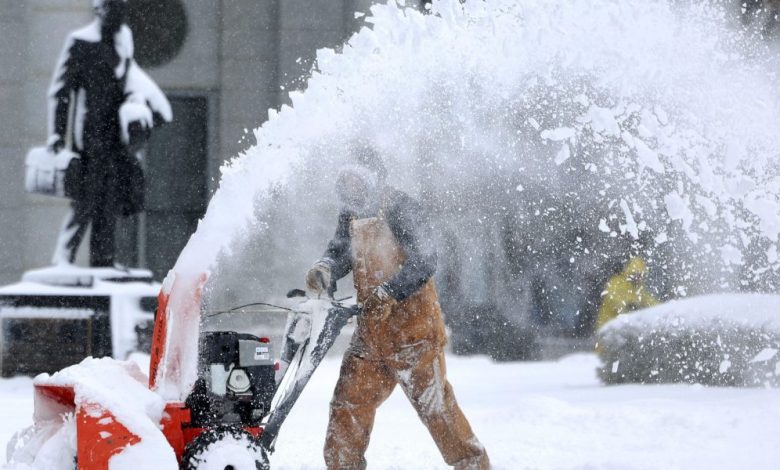Brutal winter storms will hit California

A brutal winter storm that trapped motorists on icy roads, blacked out hundreds of thousands of homes, grounded planes and closed schools across much of the country was poised to hit California Thursday.
“We have a VERY busy week ahead of us!” The San Diego office of the National Weather Service tweeted. “We have issued warnings of damaging winds, heavy mountain snow, highly hazardous boating conditions and the list goes on.”
For the first time since 1989, the Weather Service issued a snowstorm warning for the Southern California mountains through Saturday. Some coastal areas could see 10-foot (3 meter) waves — and some up to 14 feet (4.3 meters) — by Thursday, forecasters said.
“Almost all of CA’s population will be able to see snow from any vantage point later this week if they’re facing the right direction (i.e., the highest hills nearby),” UCLA climate scientist Daniel Swain tweeted Wednesday.
The storm, one in a series expected to ravage the country throughout the week, sowed chaos from coast to coast. At one point Wednesday, more than 65 million people in more than two dozen states were under weather warnings.
The wintry mix hit the northern US hard, shutting down schools, offices and even the Minnesota legislature. About 90 churches in western Michigan have canceled Ash Wednesday services, WZZM-TV reported.
In Wyoming, the state Department of Transportation posted on social media that roads were impassable in much of the southern portion of the state.
Rescuers tried to reach people stranded in vehicles, but high winds and driving snow created an “almost impossible situation” for them, said Sgt. Jeremy Beck of the Wyoming Highway Patrol.
“They know their locations, it’s just hard for them to get them,” he said.
In the Pacific Northwest, high winds and heavy snowfall in the Cascade Mountains prevented search teams from reaching the bodies of three climbers killed in an avalanche on Washington’s Colchuck Peak over the weekend.
Unexpectedly heavy snowfall during rush hour spun dozens of cars in Portland, Oregon, causing hours of traffic jams. The regional bus service offered homeless people free rides to warm shelters.
In Arizona, about 180 miles (289 kilometers) of Interstate 40 were closed, while in New Mexico state police closed ramps in Gallup on the other side of the Arizona line.
The National Weather Service warned of the potential for blinding, windswept snow, particularly Thursday afternoon into the night, when as much as 1.2 inches per hour could fall.
In California, a snowstorm warning was in effect through Saturday for higher elevations in the Sierra Nevada, where forecasters said conditions could include several feet of snow blown by 60-mph gusts and wind chill could drop the temperature to minus 40 degrees Fahrenheit (minus 40 degrees Celsius).
In Sacramento, the state capital, the weather service said it had received reports of what could be either hail or sleet — soft, wet snowflakes trapped in supercooled water droplets.
Power grids took a hit when ice-encrusted utility lines in the north and gusty winds flattened lines or littered them with tree branches and other debris in California.
Half an inch of ice covering a wire “is equivalent to a small wing on that single span of wire, so the weight is significant,” said Matt Paul, executive vice president of distribution operations at Detroit-based DTE Electric.
More than 579,000 customers in Michigan, well over 117,000 in Illinois and around 45,000 in California were without power as of Wednesday night, according to website PowerOutage.us.
The weather has also contributed to nearly 1,800 flight cancellations in the United States, according to flight tracking service FlightAware. Another 6,000+ flights were delayed across the country.
At Denver International Airport, Taylor Dotson, her husband Reggie and their 4-year-old daughter Raegan faced a two-hour flight delay to Nashville on their way home to Belvidere, Tenn.
Reggie Dotson was in Denver to apply for a job as an airline pilot.
“I think it’s kind of funny that we experienced these kinds of delays when he’s looking to pursue a career,” said Taylor Dotson.
Few places were spared the ferocious weather, including some at the opposite extreme: cities in the Midwest, mid-Atlantic and Southeast shattered long-standing record highs.
Nashville hit a high of 26.67 degrees Celsius on Wednesday, breaking a 127-year-old record for that date, according to the weather service.
Indianapolis, Cincinnati, Atlanta, Lexington, Kentucky and Mobile, Alabama were among many other record holders.
No warming was forecast this week, however, and parts of Minnesota and Wisconsin in the northern U.S. could see more than 18 inches, the National Weather Service said Wednesday night. According to the Weather Service, the largest snow event on record in the Twin Cities from October 31 to November 3, 1991 was 28.4 inches (72 centimeters).
Temperatures could drop to minus 20 degrees Fahrenheit (minus 29 degrees Celsius) on Thursday and minus 25 degrees Fahrenheit (minus 32 degrees Celsius) on Friday in Grand Forks, North Dakota. Wind chills can drop to minus 50 F (minus 46 C), said Nathan Rick, a weather forecaster in Grand Forks.
The storm will move toward the East Coast later this week. Places where there is no snow can get dangerous amounts of ice, meteorologists have warned.



